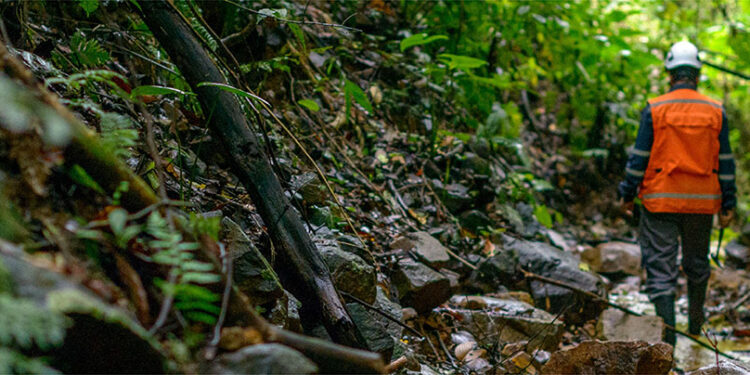Collective Mining Ltd. (TSXV: CNL) has received promising assay results from an additional two drill holes completed from Pad 7 at the Apollo Prospect in Colombia.
Drilling at Apollo in 2023 has been focused on discovering and defining shallow, high-grade mineralization below surface outcrops. With additional financing in place, the company has expanded the aim of the program to include long step out holes.
The Apollo porphyry deposit is a high-grade, bulk tonnage copper-silver-gold system, which owes its excellent metal endowment to an older copper-silver and gold porphyry system being overprinted by younger precious metal rich, carbonate base metal vein systems (intermediate sulphidation porphyry veins) within a magmatic, hydrothermal inter-mineral breccia body currently measuring 395m x 385m x 915m and open for expansion.
“The latest assay results continue to demonstrate that the Apollo system has world-class grades for an outcropping bulk tonnage porphyry system,” Executive Chairman, Ari Sussman, said.
“With a strong treasury now in hand due to the recently closed financing, the company will aggressively look to expand the Apollo system with step out deep drill holes like APC-49 currently underway and by testing satellite targets within the Apollo area. More details on the revised and expanded drilling plan for the remainder of 2023 will be provided shortly.”
The Phase II drilling programme of 2023 is advancing on schedule with eleven holes completed and a further five holes in the lab awaiting assay results. Since the discovery of the Apollo porphyry system was announced in June 2022, a total of 42 drill holes (approximately 18,000m) have been completed and assayed.
APC-40 was drilled to the southwest from Pad 7 to a maximum downhole depth of 214.55m and was targeted to intersect the contact zone between the mineralized breccia and the adjacent porphyry mineralization to the southwest. The hole intersected continuous and strong copper, silver and gold mineralization from surface bedrock to a depth of 169.25m (188m vertical due to topography) with the following assay results highlights including: 169.25m @2.81g/t gold equivalent (consisting of 1.93g/t gold, 19g/t silver and 0.38% copper) including: 16.75m @3.37g/t gold equivalent from bedrock in oxides, and 11.95m @9.57g/t gold equivalent from 18.25m , and 44.85m @3.99g/t gold equivalent from 87.85m.
Deep drilling (APC-49) has recently commenced from Pad 6 with visuals highlighting continuous porphyry and breccia style mineralization from surface to its current depth of 783m. Drilling of APC-49 continues as of publication of this release and represents the longest mineralized intercept drilled to date into the Apollo system.
Five additional shallow drill holes have been completed from drill Pads 6 and 7 with fan drilling in various directions extending the outcropping mineralization to the west and northeast. Visual observations indicate continuous mineralization from surface over core lengths ranging from more than 80m to more than 425m. The company presently has three diamond drill rigs operating at the Apollo project and additional assay results are expected in the near term.
Two new pads have recently been completed (Pad 9 and Pad 10) with drilling underway from both pads. The pad locations were chosen in order to provide more drilling options to test the potential for westerly and easterly extensions of the shallow portion of the Apollo system.
The Apollo target area, as defined to date by surface mapping, rock sampling and copper and molybdenum soil geochemistry, covers a 1,000m x 1,200m area and represents a large and unusually high-grade Cu-Ag-Au porphyry system. Mineralization styles include early-stage porphyry veins, inter-mineral breccia mineralization and multiple zones of porphyry related late stage, sheeted, carbonate-base metal veins with high gold and silver grades. The Apollo target area is still expanding as the Company’s geologists have found multiple additional outcrop areas with porphyry veining, breccia, and late stage, sheeted, carbonate base metal veins.
For further information please visit: https://www.collectivemining.com/












